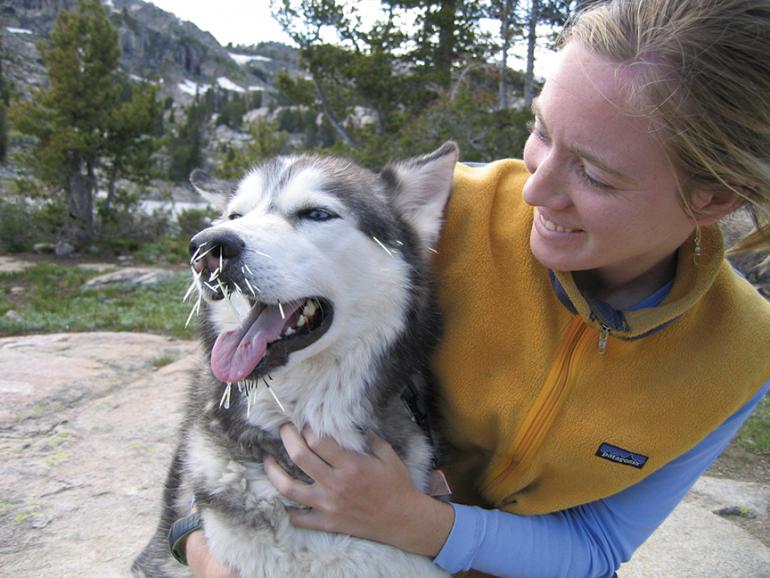Doggy Diagnosis
Examining your dog: determining the seriousness of injury and illness.
If you suspect your dog has been injured or is sick, but don’t know where or what is wrong—or how wrong it is—stop, collect your wits, leash and table the animal, and begin a systematic and thorough exam.
Examination
Soothe your dog with petting and verbal reassurance, then lift his upper lip to check his gums for color. Pink is good; it indicates no immediate life-threatening situation. After the gums are checked, systematically feel your dog everywhere. If the right leg is injured, feel the left leg first to let your dog know what you are up to and to understand what is normal on the non-affected limb. Attempt to locate the specific area of pain, injury, or discomfort. While feeling and bending the limbs, note if your dog winces, whines, or is reluctant to allow a certain area of his body to be examined. Watch for any misshapen or asymmetrical appearances. Take note of hair loss or any blood; try to determine the source. Compare any injured body parts (eye, ear, ribs, limb, footpad, etc.) to the opposite, normal body part, or to the corresponding anatomy of another dog.
Examination Checklist
Head: Systematically inspect, smell, and feel the ears, eyes, nose, mouth, teeth, tongue, oral cavity, and neck.
Legs: Check for irregularities of the joints and bones. Check toenails and pads for cracks, cuts, or abrasions. Explore the webs of the feet, removing any foreign bodies.
Chest: Feel the chest movement. If labored or irregular, place your ear on the chest and listen. Determine the breaths per minute to obtain a reference value to monitor subsequent improvement or deterioration.
Abdomen: Gently palpate the stomach, a hand on each side. Note tenderness, tenseness, enlargements, or emptiness, as well as any distress involved during palpation. Listen for gut sounds. Check the anus and reproductive organs; observe any fecal staining and watch for future bowel movements, specifically color and frequency. Pay attention to your dog’s appetite and drinking. Note frequency, contents, and volume of any vomiting. A bloated abdomen is an extremely serious sign and may indicate a life-threatening condition, especially if the bloat occurs rapidly and with labored breathing, weakness, and discoloration of the gums.
Vital Signs: Measure and record your dog’s vital signs; that is, numerically determine his breathing rate, pulse, and temperature. To know how seriously your dog is injured, these indices must be measured, and then periodically re-measured, in order to chart for better or worse the progression of your dog’s condition.
Vital Signs
Vital signs are the measurements of essential physiologic functions—temperature, pulse, and respiration (TPR)—as well as gum color. Pink gums indicate normal circulation, respiration, and heart function. Pale, white, purple, or muddy gums indicate serious injury or illness. Vital signs indicate the seriousness of injury or illness and help determine how you should address the problem at hand before seeking professional care. Heartbeats per minute, breaths per minute, temperature, and gum appearance vary with your pet’s breed, age, conditioning, size, diet, and state of activity. In order for you to correctly assess your dog’s condition in an emergency, it is important to be familiar with his normal vital signs.
Average respiration at rest is typically 15-30 breaths per minute. If the dog is not panting, observe the chest rise and fall (one full breath). Count the breaths per minute. Remember that panting due to heat and exercise skews the respiratory rate (since dogs sweat only at the margins of their footpads, they pant to dissipate heat and cool themselves). Respiratory function is difficult to determine in a panting dog, but the time required for your dog to recover from panting, heat, and exercise is important. Panting should diminish within 15 minutes after exercise in cool conditions. Persistent or excessive panting in the absence of exercise or heat can indicate anxiety, pain, illness, or injury.
Resting pulse or heart rate should be 50-150 beats per minute. The average dog’s heart beats 80 times per minute; rates tend to be faster for small breeds and pups and slower for larger breeds. There is also significant variability between individual dogs. Know your dog’s normal resting rate. You can feel the heartbeat low in the chest between your dog’s elbows. The hind leg pulse can be felt along the femoral artery inside of the thigh, very high in the groin along the thigh bone.
Body temperature should be between 100 and 103 degrees Fahrenheit. A thermometer gives the only accurate measure of body temperature. (A dry or wet nose indicates hydration rather than temperature, although feverish dogs are vulnerable to dehydration.) If a thermometer is not available, feel inside the mouth. If it’s cold, it could mean shock or a low body temperature. You may be able to identify a fever by feeling deeply into your dog’s ears with your thumbs. An accurate temperature should be taken rectally with a clean, lubricated (K-Y jelly, Vaseline, or soap) rectal thermometer. A digital thermometer is best—it’s the easiest to read, there’s no need to shake it down, and, unless the batteries fail, it’s more dependable and less likely to break in the backcountry. (Water can damage a digital thermometer, however, so keep it dry.) If you cannot insert the thermometer, you may be able to pinpoint constipation as the cause. Pain or redness can indicate diarrhea that you did not otherwise observe. You should also note the odor of the stool and the presence of any blood on the thermometer.
Capillary refill time (CRT) is generally less than one second in a healthy dog. Pink or pale pink is the normal color of unpigmented gums. Black gums cannot be used to determine capillary refill time. The time it takes for capillaries to refill after being blanched determines the state of the dog’s circulation—a critical parameter. Assess CRT by applying light finger pressure on the gums above the upper teeth, blanching the area by pushing the blood out of the capillaries. It may take a couple of pushes to get a good reading. The blanched gum should refill to its normal pink color within one second—indicating the circulation is relatively normal and that shock or circulatory failure is not imminent. If the gum capillaries take two seconds or longer to refill, the dog may be in shock and you should seek veterinary care—especially if CRT increases over time. A three-second refill time is grave. Longer refill times and purple, discolored gums indicate big trouble. In those cases, you should stabilize the dog, provide assisted breathing and heart massage as needed, and seek immediate veterinary care.
If the weather is moderate, your healthy pet should recover to his normal parameters of respiration, heart rate, temperature, and pink gums within fifteen minutes of rest after strenuous activity. Hot weather may cause persistent panting, indicating your dog requires cooling. If your dog requires a prolonged time to recover to his normal vital signs, this indicates serious illness, heat prostration, internal injuries, or circulatory shock.
This article is adapted from First Aid for the Active Dog by Sid Gustafson, DVM. Sid is also a novelist, author of the literary novel Prisoners of Flight and several stories in various literary anthologies. Find more at sidgustafson.com.











